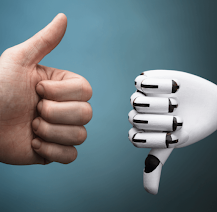Introduction
The Age of AI is a documentary about a look at how artificial intelligence is developing and a display of forward-thinking creators. Artificial intelligence is a collection of numerous technologies that work together to give robots the ability to see, understand, act, and learn at levels of intellect comparable to that of humans. It's possible that this is the reason why different people define artificial differently: AI encompasses a variety of concepts. AI is capable of learning to become more sophisticated and can store an enormous quantity of data that humans are unable to comprehend. The panorama of AI includes technologies like machine learning and natural language processing. Each developing along its own trajectory and, when used in conjunction with data, analytics, and automation, can assist organizations in achieving their objectives, whether they be enhancing customer service or streaming the supply chain. Although the exponential growth of artificial intelligence only started in the mid 1950s, I believe most people could not survive without it.
Positive Impact
AI has enormous economic potential. Throughout the history of technology, it has contributed to the world's expansion, improvement, and growth. It is constantly being improved to function more intelligently, quickly, and effectively. New discoveries made by artificial intelligence have the potential to progress humanity beyond our wildest dreams. The most difficult board game in the world, AlphaGo, is featured in the documentary film.
They displayed one of the top AlphaGo players in Asia competing against an AI program, with the human player only outperforming the machine once. For those who are familiar with the game and are aware of the tactics and abilities required to win, this was both extremely thrilling and terrifying. The AI could come up with brand-new moves that no one had ever considered before. It is absurd to consider how fast artificial intelligence can solve and advance problems that took humans decades to master and create. This has a lot of advantages for creativity and discovery.
Negative Impact
It will widen the economic gap in society and increase inequality. It will eliminate jobs while giving the owners the entire profit. As a result, the bulk of our middle and lower classes are now unemployed or have no other means of support. Changes in how we intend to distribute the capital from artificial intelligence will have an impact on society and lead to a conflict between capital and labor This has happened at numerous factories as well as during our daily lives. Advances in technology have allowed machines to replace human labor in production. Additionally, routine professions like grocery store checkouts have been replaced by machines along with factories.
AI is a tool that will work for whoever controls it; if it is used maliciously, it poses a threat to civilization. Computer scientists, for instance, are comparable to those who have called for nuclear war. These technologies are so simple to get into the hands of someone who want to do us harm.
Security and Privacy
When it comes to privacy and security, everyone is reluctant to know the truth; there is no real privacy when it comes to technology. Artificial intelligence is aware of many details regarding our private lives. We've grown to numb the idea that they could be exploiting our information for good or bad since it's become such a common occurrence. We now take it for granted that since AI has raised our standard of living, it will always act in our best interests. Although there is some truth to this, we must be aware that artificial intelligence can and will be employed to invade our privacy. Whether we are conscious of it or not, once our privacy has been violated, the people who possess that information have complete power and control us.
The farther the algorithms come into our lives, the more uneasy we should be. The world is attempting to become more tailored to you thanks to these computers, but this is the time when you need to remain vigilant and maintain control over your surroundings before businesses try to take control of you. Because social media sites use us, social media consumers are not users; attempting to manipulate us and our material to gain an advantage and profit. The private human experience of surveillance capitalism is promoted as a free source of raw materials used to forecast human behavior. Numerous companies for-see our actions. They claim that behavior predictions are removing ambiguity from life to cast artificial intelligence in favorable light. AI is gathering as much information as it can about you. We all leave a digital footprint or digital exhaust wherever we look, and computers use this data to infer the interest of users. Companies, with your consent, are aware of your movements and where you have been gone. This frightened me, learning more about all of the access the internet and certain platforms have to your private and personal details in your life.
Reflection
One of the things that I learned is that there are different types of AI, narrow and general. The majority of what we encounter in daily life is narrow AI, which completes one task or a group of closely related tasks. The weather app, digital assistants. and software that analyzes data to improve specific business function are all examples of weak AI. These systems are strong, but their scope is limited because they are frequently drive by efficiency. However, when used properly, limited AI has tremendous transformative capacity and continues to have an impact on how people around the world work and live. General AI is more akin to the sentient computers that you see in science fiction movies that can manage a variety of challenging tasks and can reason strategically, abstractly, and creatively. While some tasks can be completed by machines more efficiently than by humans, this fully realized general AI vision is still only a fantasy on the silver screen.
Collaboration between humans and machines is essential since, in the modern world, artificial intelligence still serves to augment rather than to replace human abilities. This surprised me in the way that our world is vastly developing more and more each day and certain machines have so much power like a human being. Overall, technology has evolved into a tool of control rather than liberty. Awareness, erasing our past, and minimizing the quantity of information we share so openly are some ways to combat this. We must take control before artificial intelligence can rule us and we cannot be reckless with our privacy.












































